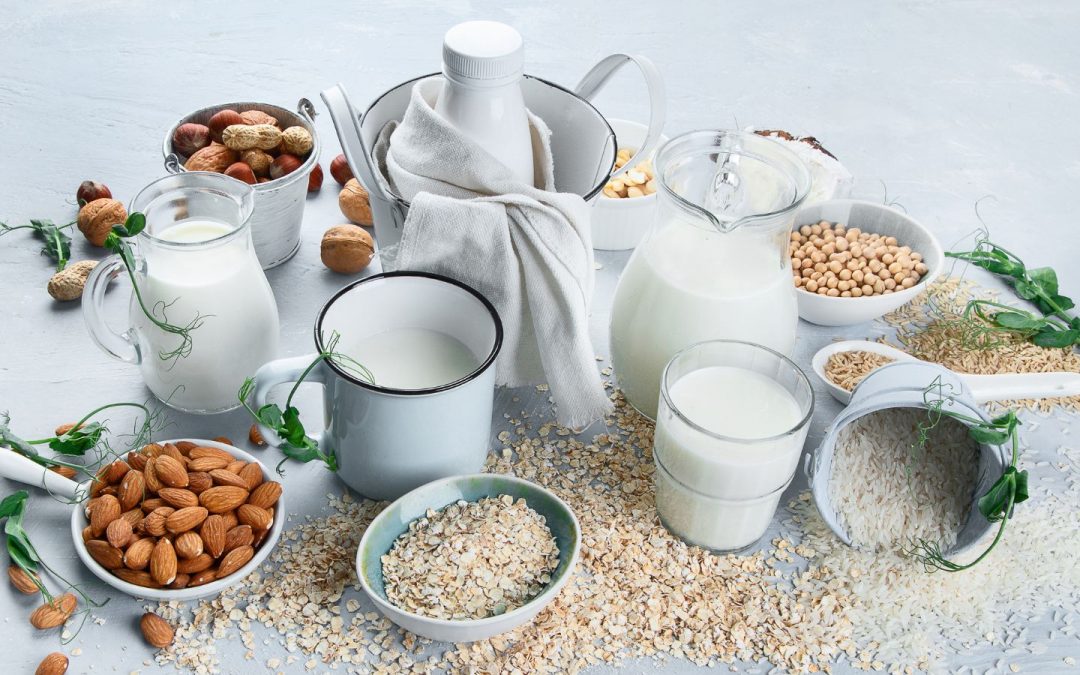
By Cordelia Woodward, Registered Dietitian, MyNutriWeb
A growing number of people are choosing to shift towards more plant-based diets(1). Transitioning to incorporate plant-based dairy alternatives (PBDA), such as plant-based drinks (PBD) and plant-based yogurt alternatives (PBYA), can be a component of this dietary shift. We’ve witnessed a notable surge in the PBDA market both globally(2) and across Europe(3), offering a wide array of options that include varieties based on soya, oats, rice, peas, almonds, and numerous other alternatives.
With so much choice on the market, it becomes crucial to comprehend the dietary significance of PBDA for the health of both people and the planet. Indeed, a recent survey found that 17% of individuals had reduced their intake of dairy, while 24% had included PBDA in their shopping baskets(4). This dietary evolution is motivated by a number of factors, with a key reason being the drive for concerns in human and planetary health due to the lower environmental impact PBDA can have compared to dairy products.
Research into the health and environmental impacts of PBDA in the diet has been limited (with most research focusing on the role of whole plant-based foods(5)), so we’re pleased to see the release of two papers in the latest edition of the journal ‘Nutrients’. These papers delve into the role of PBDA both environmentally and nutritionally.
Nutrilicious Nutrition Communications was commissioned by the Alpro Foundation (not for profit organisation) to co-ordinate this research and Elphee Medici, Nutrition and Sustainable Diets consultant at Nutrilicious was an author on both papers.
The new publications
This study analysed the nutritional profiles of leading PBDA across Europe and compared them with their dairy counterparts. A comprehensive analysis of the nutritional profiles of 309 unflavoured PDDA products including 249 PBD and 52 PBAY was undertaken.
Key findings:
Macronutrient Profile: PBDA displayed a favourable macronutrient profile despite lower protein levels (see below). Energy, fat, saturated fat, carbohydrates, total sugars, fibre and protein were assessed.
Protein Levels: PBDA, with the exception of soya varieties, generally had lower protein levels compared to their dairy counterparts. However, the study emphasised that this lower protein content could be compensated for by incorporating other protein-dense foods into a balanced diet.
Saturated Fat Content: With the exception of coconut varieties, both PBD and PBAY were found to be low in saturated fat, containing less than 1 gram per serving.
Sugar Levels: 70% of PBDA were unsweetened, and most had sugar levels comparable to those found in dairy products.
Fortification of Micronutrients: Micronutrient information most commonly associated with dairy milk and yogurts was collected including:
- calcium, iodine, vitamin D, vitamin B2, vitamin B12, and vitamin A.
Overall, the analysis demonstrated that when micronutrients are added to PBDA, they are often at levels comparable to European dairy.
Among the non-organic PBDA, 76% were fortified with one to six micronutrients. 76% of the non-organic PBDA were fortified with calcium, 66% with vitamin D, and 60% with vitamin B12. Less than half were fortified with B12, 11% with iodine and 6% with vitamin A.
Looking at calcium fortified PBD, the majority provided a median of 300mg calcium per 250ml serving, which is comparable to dairy milk. For vitamin D, PBD provided a median of 1.88 mcg per serving, which was greater than dairy milk at 0.03 mcg per serving.
Overall, PBAY products were less frequently fortified (62%) compared to PBD (81%). This difference in fortification between the product types was noted by the authors who commented that ‘Improved fortification is needed across all categories to rectify the existing imbalance between PBD and PBAY fortification.’
Organic PBDA Nutrient Profile: Organic PBDA products were found to lack certain micronutrients due to legal restrictions on fortification.
Integration into Dietary Guidelines: The study suggests that enhancing fortification consistency with dairy-associated micronutrients in PBDA could address concerns regarding their suitability as dairy substitutes and their integration into food-based dietary guidelines (FBDG).
Overall, the analysis supports the inclusion of fortified PBDA in environmentally sustainable FBDG for healthy populations, highlighting their role as a viable and environmentally friendly alternative to traditional dairy products.
The authors concluded that:
‘Fortified PBDA can help shift consumers towards more sustainable eating patterns, and their macronutrient profile, except for coconut varieties, is conducive to improved health outcomes. As PBDA continue to grow in popularity, there is a need to have consistency in micronutrient fortification and help consumers incorporate them in the context of healthful and varied diets.’
This paper analysed the environmental impacts of dairy milk and PBD. The impact (environmentally, nutritionally and from a behavioural change perspective) of replacing one serving (250ml) of dairy milk in the EAT Lancet’s Planetary Health Diet (EAT PHD) with fortified PBD was assessed. The EAT PHD is a global reference diet created to represent the optimal diet for both people and the planet. Data for PBDs was based on soya, oat and rice based varieties.
Key findings:
Nutritional Adequacy:
Overall: The authors highlighted that ‘When one serving of dairy milk in the EAT Lancet’s Planetary Health Diet model is replaced by a serving of a fortified PBD, the overall nutrient content of the diet experiences minimal changes while significantly reducing the environmental impact.’
Protein: Protein intake is marginally reduced by 1% and 7%, respectively, when soya and rice or oat drinks are substituted for dairy milk. However, replacement of dairy milk in European populations with PBD containing lower protein levels will not risk compromising one’s protein status because their overall protein intake typically excessed daily requirements. The paper highlights that ‘dairy milk is not essential to ensure an adequate protein intake in European adult populations.’
Micronutrient Content: When one serving of dairy milk in the EAT Lancet’s PHD is replaced by a serving of a fortified PBD, calcium levels remain unchanged with levels found to be comparable to dairy. Vitamin A, D, B2 and iodine levels increased, while vitamin B12 levels decreased by 5%.
Environmental Impact Reduction: Compared to dairy milk, the PBDs examined in the study demonstrated a substantial reduction in greenhouse gas emissions (GHGe) (59–71% per 250 mL), lower land use, and reduced eutrophication impact.
Water Usage: Oat and soya based PBDs showed significantly lower water usage compared to dairy milk, although this trend was not observed in rice based drinks.
Ultra-Processed Foods (UPFs) Classification: Many PBDAs have been categorised as UPFs, which may imply adverse nutritional and health associations, often exacerbated by the media coverage around UPFs. However, this classification appears inconsistent with current findings regarding the nutritional quality of these products. The analysis supports the use of PBDAs, highlighting their role in helping individuals transition towards a plant-based diet, offering both health and environmental benefits.
Behavioural: PBDA can help overcome consumer barriers to dietary change due to their availability, accessibility, and social acceptance. Additionally, as they can be used in a similar way to dairy milk, no new skills need to be learnt.
The authors concluded that ‘Imperative to the growth of PBDAs is the willingness to adopt sustainable dietary recommendations and give the assurance that these drinks support a healthy and environmentally sustainable diet. Our observations highlight that substituting dairy milk with a fortified PBDA does not compromise the overall nutritional quality of the diet while significantly reducing the environmental footprint.’
Summary
With present concerns around climate change, planetary health, and the need to shift towards more sustainable diets, it’s essential we understand the role of PBDA. PBDA have emerged as a promising solution to promote more sustainable dietary patterns.
The new research supports inclusion of fortified PBDA in environmentally sustainable FBDG for healthy populations. Substituting dairy milk with a fortified PBDA in the general population, in line with the principles of a planetary health diet, maintains the overall nutritional quality of the diet while having a significant reduction in environmental footprints.
Both papers are available to view on the Alpro Foundation website, alongside other key publications in the field of nutrition and sustainability.






